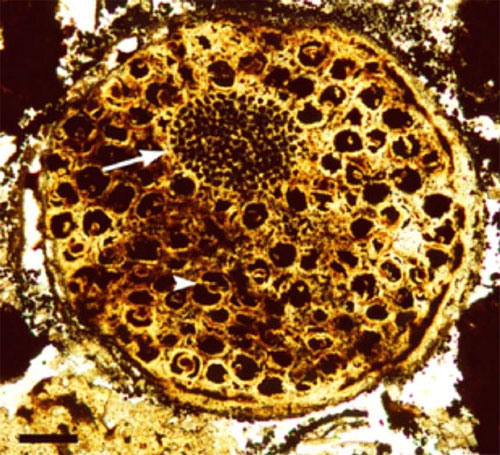Discover Cambrian multicellular fossil fossil in China
The pre-Cambrian fossil discovered in the rocks of southern China suggests that the life of complex multicellular organisms appeared at least 600 million years ago.
This spherical fossil was discovered in phosphorite rock collected in Guizhou Province, China in 1997.

Photos: Sci-News
Some previous studies have explained microorganisms, called Megasphaera , like bacteria, single-celled eukaryotes, algae, symmetrical bilateral animals or transitional forms related to existing animals. Great like sponges and anemones. However, their complete life cycle has only recently been decoded.
In a new study, published in Nature, a group of paleontologists under the leadership of Dr. Xunlai Yuan of the Institute of Geological Geology and paleontology described microfossils Megasphaera that had previously been Although neglect has been collected nearly two decades ago.
Fossils representing Megasphaera show that complex multicellular cells are different from simple bacteria and appeared at least 600 million years ago.
This Sci-News quoted Professor Shuhai Xiao as saying that this opens a new direction for the study of the time and evolution of multicellular organisms.
The title has been changed.
- Multicellular organisms may exist before the Cambrian Period
- Root the explosion of life on Earth
- The explosions of life
- Discover giant shrimp fossils, razor-sharp teeth
- Learn the world's oldest brain fossil
- Discover the oldest fossil fossil in Tibet
- Creating multicellular life in vitro
- Discover the most complete dinosaur fossil
- China found 7 million years old bird fossils
- Flying lizard eggs 120 million years in China
- Discover fossil giant footprints in Western China
- China: Pile the foundations, discover 10,000-year-old rare objects
 Discovered an ancient centipede fossil 99 million years old
Discovered an ancient centipede fossil 99 million years old Discovered bat-like dinosaurs in China
Discovered bat-like dinosaurs in China Discovered a 200-year-old bronze cannon of the coast
Discovered a 200-year-old bronze cannon of the coast Discover 305 million-year-old spider fossils
Discover 305 million-year-old spider fossils